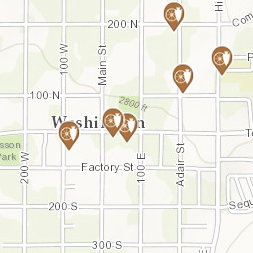Washington City Utah | (435) 656-6300
letusknow@washingtoncity.org
111 North 100 East | Washington, Utah 84780 [map]
© 2025 Washington City Corporation. All rights reserved.
Privacy Policy
Heritage, Pride, Progress
Washington City Museum (staffed by volunteers, hours vary call for information)
25 E Telegraph
Washington, Utah 84780
(435) 986-4228
A Brief History of Washington City
-Washington City Historical Society 15 April 1999 - Harold Cahoon
The Cotton Mission
Thousands of people left their homes to come to Northern Utah to find a new life, and to live the religion of their choice. Arriving exhausted and ill, having hastily buried hundreds of loved ones along the way, they started their new lives. From this weary group, Brigham Young asked thirty-eight (38) families, all from the southern states, to travel to Southern Utah to grow cotton. These southerners were from Mississippi, Alabama, Virginia, Texas, Tennessee and the Carolinas. This was the Cotton Mission, or sometimes called the Southern Mission. Washington City was the first town established in the Virgin basin for the purpose of colonizing the land so that cotton could be grown.
"Grow cotton," he challenged them, knowing that war between the North and South would soon erupt. Cotton would not be available for use by these Utah pioneers. This directive was given to people who had left the fertile South to make their trek to Utah. They knew how to grow cotton, or at least had seen it grown.
These families were the forerunners of what would become known as "Utah's Dixie"-- so named by these stalwart Southerners, who were no doubt homesick for the lives they had left behind. The name spread to the surrounding areas known as "Utah's Dixie" today.
Washington City Established
Brigham Young wanted his people to be self-sustaining and independent of others whom he called Gentiles. Ten families, under the direction of Samuel Jefferson Adair, arrived in the Washington area on April 15, 1857. They knew exactly where they were going because John D. Lee had traveled this area in 1852 and reported to Brigham Young that the area had plenty of water, and that there was flat, good agricultural land south of the Virgin River. He also reported that many tropical plants and fruits could be grown here, including cotton and sugar cane.On May 5 or 6 twenty-eight (28) more southern families came under the leadership of Robert D. Covington. He had actually been a plantation foreman that grew cotton when slaves were the workers. They met the Adair group at what is now called Adair Springs (122 N 200 E) And the next day they had a two-day conference with President Isaac C. Haight from Cedar City. They laid out the city and gave it the name of Washington after the first president of our country. They formed a branch of the LDS Church and named Covington as their leader. They also selected school trustees, constables, justices of the peace, and other positions to make the city function. The city must have been surveyed at this time since the streets are straight, wide, and at right angles to each other.
The Starving Times
The first year in Washington many lived in wagon boxes or dugouts that were dugouts on the hill on the east side of second East, known then as adair Street. They paid a high price to perform this service. Malaria was rampant, killing many and making others almost useless to perform manual work. Dysentery and typhoid fever were common, and more of the babies and youngsters died than survived. "Ague" was the name used to cover many an illness. Drinking water came fro the same ditches that cattle rummaged in. Each morning between 6 am and 7 am water was dipped from the irrigation ditches for use in their homes. It was known as "dip" water. Food was scarce; they called it "the starving times."Workers were malnourished and could hardly work a full day. In the midst of all this, men and boys dug ditches and canals. They pushed themselves to create dams so that the precious water could find its way to the fields they planted. "Surely," they pleaded in their hearts, "our efforts will be blessed."
"The ones who remained were too poor to leave"
When floods came and destroyed the dams twice in 1857, twice more in 1858, three times in 1859 and at least once each year until the building of Washington Fields Dam in 1891 that tamed the unruly Rio Virgin - they were always willing to rebuild. And they did. After a few years of such trying times many of the original pioneers left or were called to go to other locations. It was laughingly said, "The ones who remained were too poor to leave."Shortage of food for the pioneers and their animals was severe. The animals had to travel long distances to get something to eat, which required herders, and the energy exerted by the animals was great. Forage for the animals was not solved until quantities of alfalfa, known to the pioneers as "lucern" was planted and harvested. Doing all of this type of work by hand was difficult and time consuming.
Fencing was also a problem. The early crops suffered because of the lack of it. The animals were allowed to roam freely which made it difficult to protect the growing crops. Rock, cedar posts, and willows were used to build fences. There were miles of rock fences in Washington until recently.
The Cotton Factory is built
The Cotton Mission needed help and Brigham Young provided that help. He had them build the Cotton Factory in Washington, starting in 1865. He called 309 families in 1861 to come and augment the cities along the Virgin, stated the Tabernacle in 1863 and the Temple in 1871. All were aids in making the missions here success.Santa Clara grew small amounts of cotton in 1855 and 1856 to show that cotton could be grown here. The newly grown cotton produced a satisfactory lint. Cotton was successfully grown commercially, and Washington produced the most cotton. To make the industry complete Brigham Young had the Cotton Factory built to produce cloth that could be used for clothing, etc. Without the Cotton Factory, the Cotton Mission would not have endured.
Washington City Today
Today Washington City is a thriving city that is attractive to many both retired and young. It is one of the cities of Southern Utah that has exploded with population growth. New homes are being constructed to supply the needs of shelter. Hotel’s are being built to provide rest for the continued increase of tourists and visitors, and new businesses break ground to help increase services and entertainment for the community. Washington City will continue to be an oasis of opportunity for everyone. But with growth comes challenges. It’s never easy to balance the future needs with historic ideals.The City has a very challenging professional golf course that draws players from all over the west because of its design and difficulty. There are numerous beautiful parks throughout the city that are pristinely maintained. There is even a park just for dogs. And one of the great historic sites of Washington City is Warm Springs with it’s consistent water flow since the first records were kept that was used as dipping water for culinary use as well as irrigation and then served as a swimming hole for kids and adults; it has been invested in as a new park called The Boilers to provide a similar experience for future generations. Washington City also established a 110,000 sq. ft. Community Center in 2008 which has aquatics, basketball courts, gyms, a weight room, a walking track, outdoor pavilions, volleyball courts, and more; it provides something for everyone, all in one place.
Recently, Washington City ranked #1 among the best places to Live in Washington County by Niche, reporting living in Washington offers residents a suburban rural mix feel and most residents own their homes. In Washington there are a lot of parks. Many families, young professionals, and retirees live in Washington with one commenter saying “It's an awesome place to live because it's so family-friendly, great climate, and amazing outdoor activities to enjoy. It's located near Zion National Park, and countless others such as Bryce Canyon, Cedar Breaks, Canyonlands, and Arches National Park. Also, Sand Hollow reservoir is very close by along with the famous Lake Powell a couple of hours away.”
There are several organizations that help to promote year round activities. The local Chamber of Commerce, The Lions Club, The Sons and Daughters of the Utah Pioneers, churches, schools, and others. The Washington City Historical Society functions in helping others to preserve their legacy and to find and save the history of the city and its early pioneers.
To sum up this great pioneering city, as quoted in the Washington City magazine: "More than 135 years ago Washington City was the birthplace of the Southern Utah Cotton Mission. Today Washington City continues to enjoy its reputation as a leading city in the Washington County community where young families thrive, retired folks flourish, and visitors return again and again to enjoy the mild weather, the friendly people, the awesome landscape and the peaceful lifestyle." Washington City is Southern Utah.
Historical Sites in Washington City
- Old School/Museum
- Robert Covington Home
- Adair Spring
- Cotton Mill
- Cemetery
- Relief Society Building
- Granary
Click for a Map of Historical Sites in Washington City







Latest on Instagram: